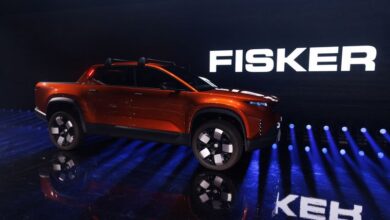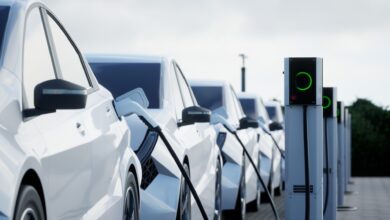Study Shows Nearly Half Of All Electric Vehicles Are Now Cheaper To Own Than Gas-Powered Models

EV transaction prices have been plummeting, averaging 12.8% lower than they were a year ago, with … [+]
To many eyes it looked as if 2024 would finally be the year electric cars go mainstream, following a 12-month period in which sales increased by a whopping 47%.
And then it wasn’t.
A spate of bad press regarding public charging, reports of dramatically reduced range in extreme temperatures and a dearth of EVs that still qualify for the $7,500 federal tax credit conspired to squelch demand. EV sales advanced by just 2.7% over the first quarter of 2024, compared to an industry-wide average 5% gain for all makes and models.
As a result, new EV transaction prices have been plummeting, averaging 12.8% lower than they were a year ago, with some models going for 20% or more less than they did in 2023. Most of us have lost count on how many times Tesla has cut prices of its all-electric line, with other automakers likewise chopping away at their bottom lines with reductions, rebates and other incentives. Many brands have figured a way for their otherwise ineligible EVs to qualify for the federal tax credit via their leasing programs.
Recent trends in EV pricing, combined with suddenly sluggish demand warranting discounts and incentives and other factors now enable 20 out of 49 battery-electric models sold in the U.S. (49%) to be cheaper to own over a five-year period than comparable internal combustion engine (ICE) rides.
Comparing Ownership Costs
That’s according to the 2024 Electric Vehicle Cost of Ownership Analysis compiled by the automotive research company Vincentric, based on a comparison of more than 5,300 vehicle configurations from the 2023 and 2024 model years. The company considered each model’s depreciation, financing, fuel, insurance, maintenance, repairs and other factors.
“With the cost of living on the rise, many American consumers are looking for ways to stretch their money. This means that buyers may be hesitant to consider an EV when many of them have a significantly higher purchase price than a comparable gas vehicle,” says Vincentric’s president David Wurster. “This is why it’s critical for consumers and the auto industry to understand the full financial benefits and detriments of EVs.
The report found that 19 of 41 EVs are able to recover their added up-front cost within seven years, with eight of them beating similar ICE vehicles immediately after driving off of a dealer’s lot, due to their lower starting prices. At the other end of the ledger, the remaining 22 EVs are predicted to take 84 months or longer to recoup the up-front excess.
Electric cars inherently come out ahead in this regard with lower energy costs (if charged at home) and maintenance expenses (fewer components that require ongoing service). The study found that while EV transaction prices averaged around $8,000 more than their closest ICE alternatives, they saved as much in energy costs, and realized an additional $1,300 pocketed over five years in ownership cost savings. The study showed that the Tesla Model Y costs an impressive $19,894 less over a five-year cycle than its arguably closest rival, the BMW X3.
On the down side, EVs still take a major hit in terms of depreciation, which is how much value a given vehicle loses over time. Only 10 of the 41 EVs sold in the U.S. had lower depreciation rates than their ICE substitutes. Tesla models took the biggest hit in resale value between 2023 and 2024, according to CarGurus.com, falling by an average 31.5-34.4%, depending on the model.
EVs With The Lowest Five-Year Ownership Costs And Greatest Savings Over ICE Vehicles
We took a deep dive into Vincentric’s data to create the following list of electric vehicles that are not only estimated to cost the least to own for five years (with 15,000 miles driven annually at average energy prices), but are predicted to realize the greatest savings over their most-comparable ICE-powered models:
- Nissan Leaf S: $46,916 ($1,534 less than Nissan Altima); eligible for $7,500 tax credit
- Volkswagen ID.4 Standard: $49,733 ($99 less than Volkswagen Tiguan); eligible for $7,500 tax credit
- Kia Niro EV Wind: $50,903 ($388 less than Kia Seltos)
- Mini Cooper Electric SE: $51,942 ($8,788 less than Mini Cooper S)
- Hyundai Kona Electric: $52,957 ($4,625 less than Hyundai Kona SE)
- Ford F-150 Lightning Pro Supercrew: $56,238 ($16,231 less than Ford F-150); eligible for $7,500 tax credit
- Tesla Model Y Standard Range: $59,406 ($19,894 less than BMW X3); eligible for $7,500 tax credit
- Tesla Model 3 Standard Range Plus: $60,127 ($13,929 less than BMW 3 Series); eligible for $7,500 tax credit
- BMW i4 eDrive35 Gran Coupe $70,953 ($9,604 less than BMW 4 Series)
- Polestar 2 Base: $72,504 ($7,699 less than Volvo S60)
- Genesis GV60 EV Standard: $72,847 ($2,925 less than Genesis GV70)
And these are the eight models Vincentric determined require a zero payback period by virtue of their lower purchase prices and other costs versus comparable ICE vehicles:
- Audi SQ8 e-tron Premium Plus
- Ford F-150 Lightning Pro Supercrew 4WD
- Mercedes-Benz EQS450+
- Mini Cooper Electric SE
- Porsche Taycan Base
- Tesla Model 3 Standard Range Plus
- Tesla Model S Long Range
- Tesla Model Y Standard Range
Source: Vincentric. The full 2024 Electric Vehicle Cost of Ownership Analysis, which includes EV rankings according to various cost variables can be downloaded here.



